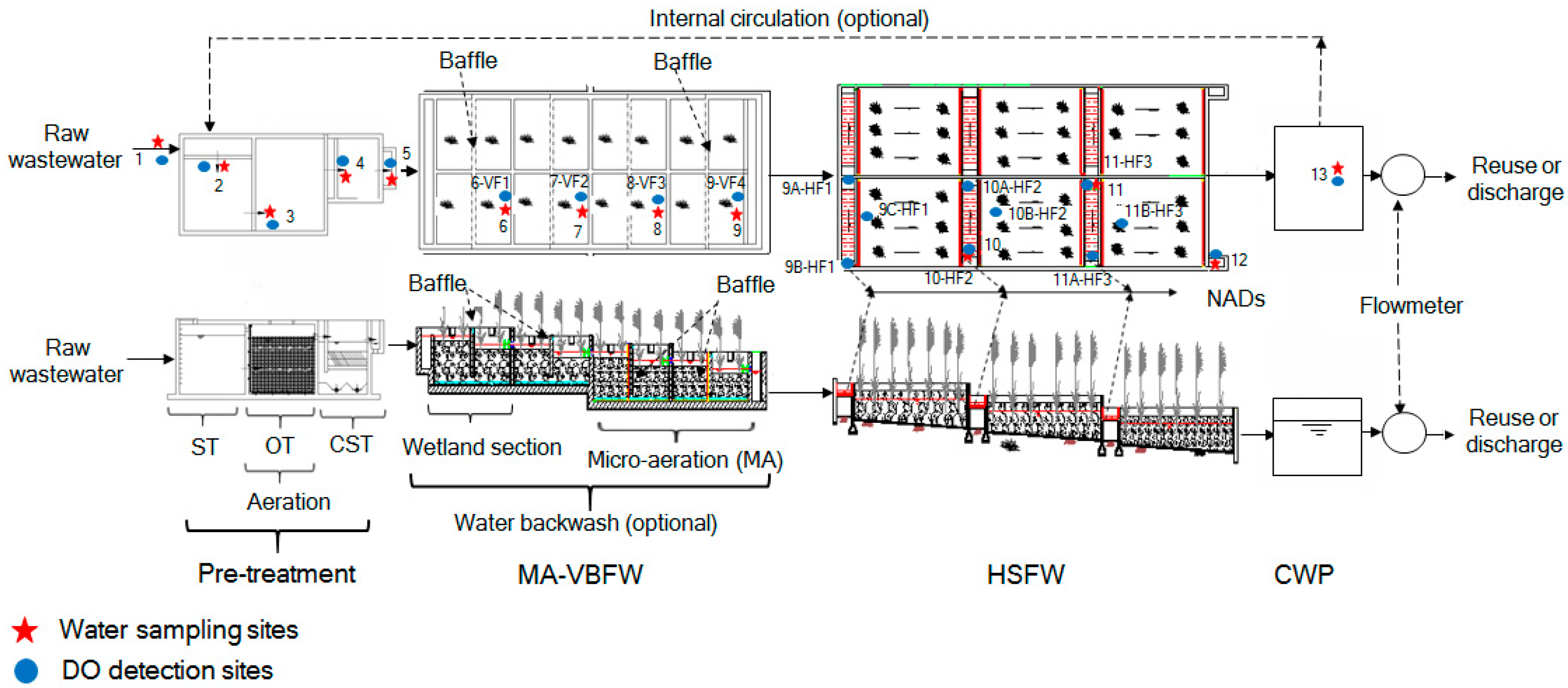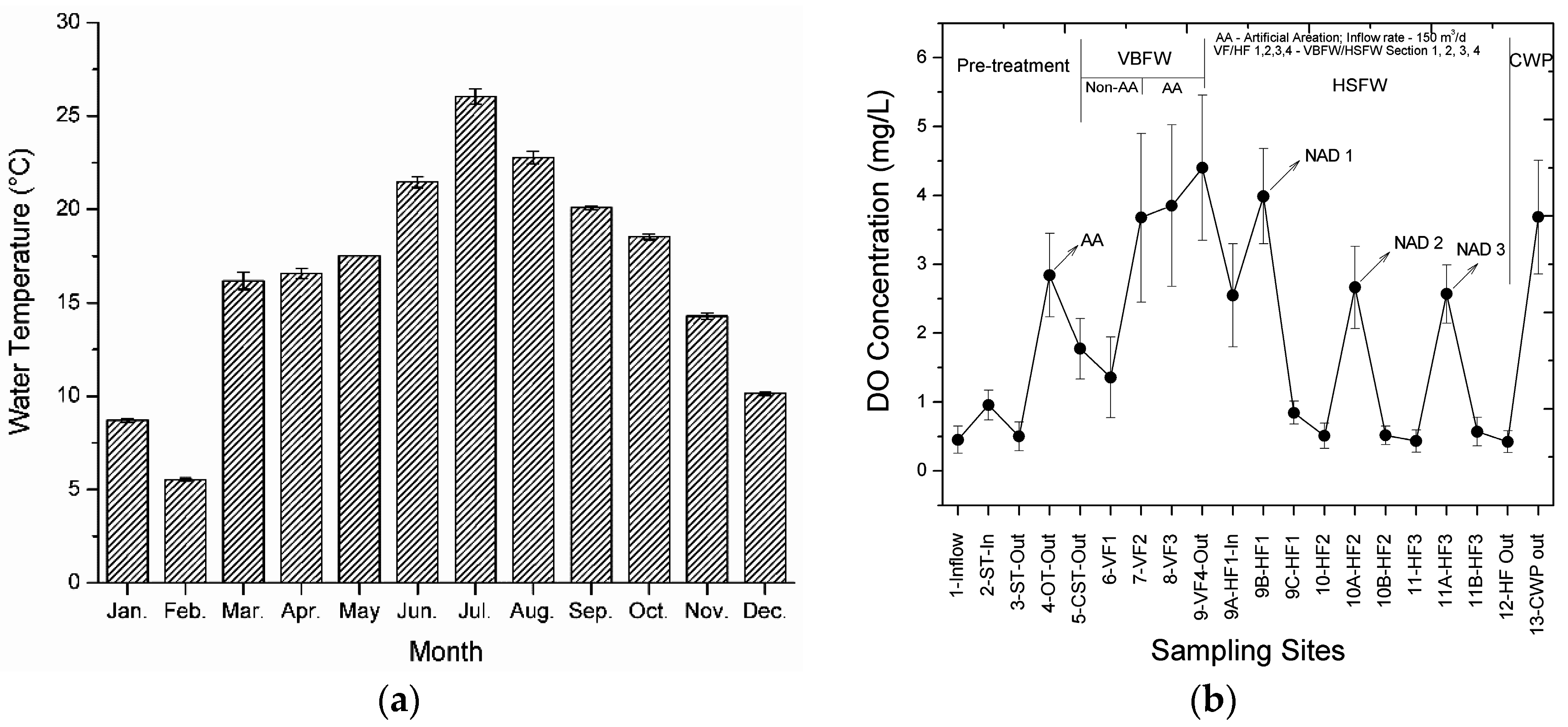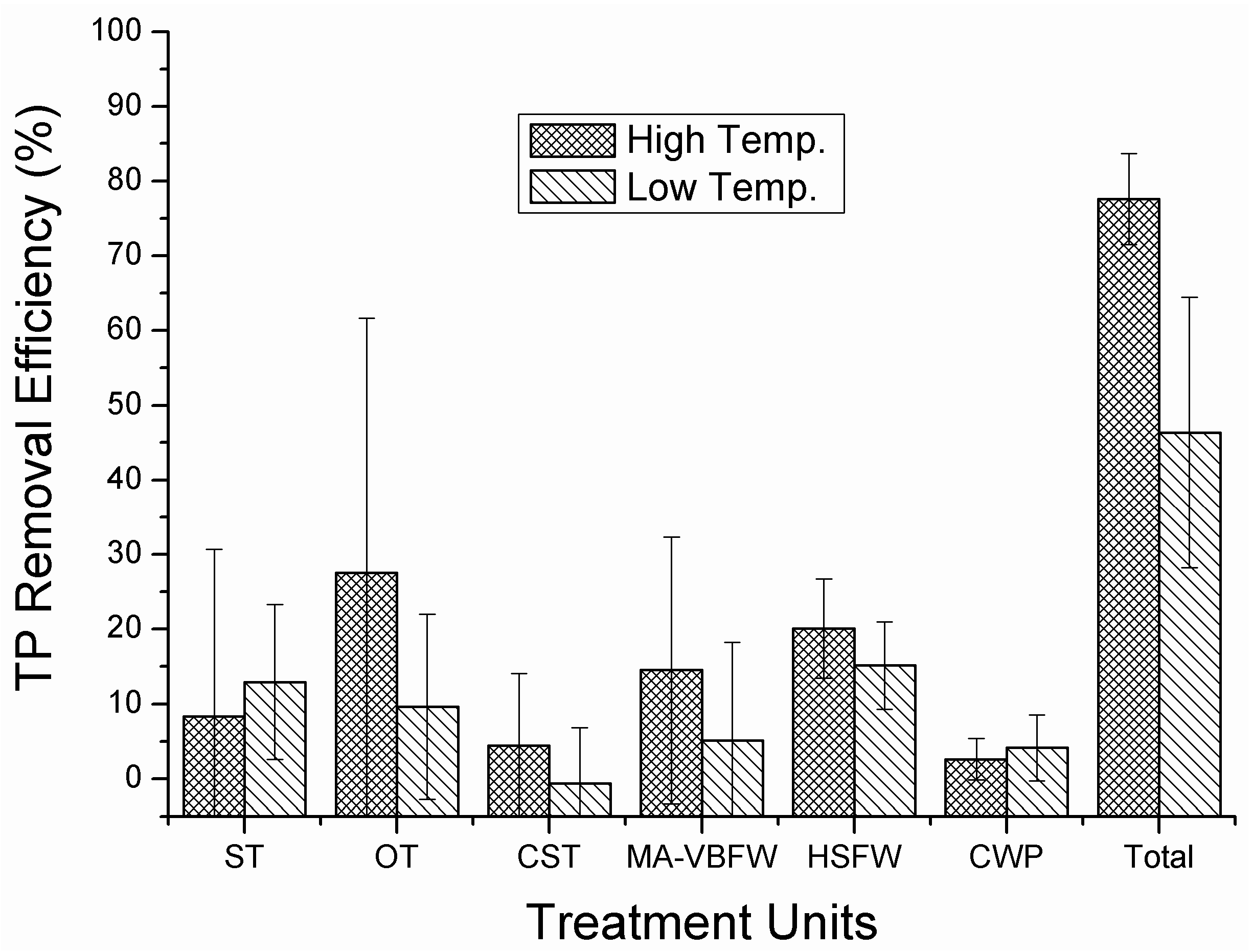Seasonal Variation of Nutrient Removal in a Full-Scale Artificial Aerated Hybrid Constructed Wetland
Abstract
:1. Introduction
2. Materials and Methods
2.1. Study Site
2.2. Sampling and Physiochemical Analysis
2.3. Statistical Analysis
3. Results and Discussion
3.1. Overall Performance
3.2. Water Temperature and DO Profile
3.3. Seasonal Variations of Organic and Nitrogen Removal
3.4. TP Removal
3.5. Water Temperature vs. Pollutants Removal
4. Conclusions
Acknowledgments
Author Contributions
Conflicts of Interest
References
- Liu, H.; Hu, Z.; Zhang, J.; Ngo, H.H.; Guo, W.; Liang, S.; Fan, J.; Lu, S.; Wu, H. Optimizations on supply and distribution of dissolved oxygen in constructed wetlands: A review. Bioresour. Technol. 2016, 214, 797–805. [Google Scholar] [CrossRef] [PubMed]
- Zhong, F.; Wu, J.; Dai, Y.; Xiang, D.; Cheng, S.; Ji, H. Performance evaluation of wastewater treatment using horizontal subsurface flow constructed wetlands optimized by micro-aeration and substrate selection. Water Sci. Technol. 2015, 71, 1317–1324. [Google Scholar] [CrossRef] [PubMed]
- Wu, S.; Kuschk, P.; Brix, H.; Vymazal, J.; Dong, R. Development of constructed wetlands inperformance intensifications for wastewater treatment: A nitrogen and organic matter targeted review. Water Res. 2014, 57, 40–45. [Google Scholar] [CrossRef] [PubMed]
- Martín, M.; Gargallo, S.; Hernández-Crespo, C.; Oliver, N. Phosphorus and nitrogen removal from tertiary treated urban wastewaters by a vertical flow constructed wetland. Ecol. Eng. 2013, 61, 34–42. [Google Scholar] [CrossRef]
- Wang, X.; Tian, Y.; Zhao, X.; Peng, S.; Wu, Q.; Yan, L. Effects of aeration position on organics, nitrogen and phosphorus removal in combined oxidation pond-constructed wetland systems. Bioresour. Technol. 2015, 198, 7–15. [Google Scholar] [CrossRef] [PubMed]
- Tang, X.; Huang, S.; Scholz, M.; Li, J. Nutrient Removal in pilot-scale constructed wetlands treating eutrophic river water: Assessment of plants, intermittent artificial aeration and polyhedron hollow polypropylene balls. Water. Air. Soil Pollut. 2009, 197, 61–73. [Google Scholar] [CrossRef]
- Pan, J.; Zhang, H.; Li, W.; Ke, F. Full-scale experiment on domestic wastewater treatment by combining artificial aeration vertical- and horizontal-flow constructed wetlands system. Water Air Soil Pollut. 2012, 223, 5673–5683. [Google Scholar] [CrossRef]
- Vymazal, J. Removal of nutrients in various types of constructed wetlands. Sci. Total Environ. 2007, 380, 48–65. [Google Scholar] [CrossRef] [PubMed]
- Maltais-Landry, G.; Maranger, R.; Brisson, J.; Chazarenc, F. Nitrogen transformations and retention in planted and artificially aerated constructed wetlands. Water Res. 2009, 43, 535–545. [Google Scholar] [CrossRef] [PubMed]
- Tao, M.; He, F.; Xu, D.; Li, M.; Wu, Z. How artificial aeration improved sewage treatment of an integrated vertical-flow constructed wetland. Pol. J. Environ. Stud. 2010, 19, 183–191. [Google Scholar]
- Wang, X.; Chen, J.; Kong, Y.; Shi, X. Sequestration of phosphorus from wastewater by cement-based or alternative cementitious materials. Water Res. 2014, 62, 86–96. [Google Scholar] [CrossRef] [PubMed]
- Vera, I.; Araya, F.; Andrés, E.; Sáez, K.; Vidal, G. Enhanced phosphorus removal from sewage in mesocosm-scale constructed wetland using zeolite as medium and artificial aeration. Environ. Technol. 2014, 35, 1639–1649. [Google Scholar] [CrossRef] [PubMed]
- Ouellet-Plamondon, C.; Chazarenc, F.; Comeau, Y.; Brisson, J. Artificial aeration to increase pollutant removal efficiency of constructed wetlands in cold climate. Ecol. Eng. 2006, 27, 258–264. [Google Scholar] [CrossRef]
- Faulwetter, J.L.; Gagnon, V.; Sundberg, C.; Chazarenc, F.; Burr, M.D.; Brisson, J.; Camper, A.K.; Stein, O.R. Microbial processes influencing performance of treatment wetlands: A review. Ecol. Eng. 2009, 35, 987–1004. [Google Scholar] [CrossRef]
- Brix, H. Do macrophytes play a role in constructed treatment wetlands? Water Sci. Technol. 1997, 35, 11–17. [Google Scholar] [CrossRef]
- Zhai, J.; Zou, J.; He, Q.; Ning, K.; Xiao, H. Variation of dissolved oxygen and redox potential and their correlation with microbial population along a novel horizontal subsurface flow wetland. Environ. Technol. 2012, 33, 1999–2006. [Google Scholar] [CrossRef] [PubMed]
- Zhai, J.; Xiao, H.W.; Kujawa-Roeleveld, K.; He, Q.; Kerstens, S.M. Experimental study of a novel hybrid constructed wetland for water reuse and its application in Southern China. Water Sci. Technol. 2011, 64, 2177–2184. [Google Scholar] [CrossRef] [PubMed]
- Vymazal, J. The use of hybrid constructed wetlands for wastewater treatment with special attention to nitrogen removal: A review of a recent development. Water Res. 2013, 47, 4795–4811. [Google Scholar] [CrossRef] [PubMed]
- Wang, L.; Li, T. Effects of seasonal temperature variation on nitrification, anammox process, and bacteria involved in a pilot-scale constructed wetland. Environ. Sci. Pollut. Res. 2015, 22, 3774–3783. [Google Scholar] [CrossRef] [PubMed]
- Arias, C.A.; Oirschot, D.V.; Kilian, R.; Pascual, A.; Carvalho, P.N.; Lv, T.; Zhang, Y.; Brix, H.; Alvarez, J.A. Design and performance evaluation of a highly loaded aerated treatment managing effluents from a food processing industry in Denmark. Water Pract. Technol. 2015, 10, 644–650. [Google Scholar] [CrossRef]
- Butterworth, E.; Dotro, G.; Jones, M.; Richards, A.; Onunkwo, P.; Narroway, Y.; Jefferson, B. Effect of artificial aeration on tertiary nitrification in a full-scale subsurface horizontal flow constructed wetland. Ecol. Eng. 2013, 54, 236–244. [Google Scholar] [CrossRef]
- Butterworth, E.; Richards, A.; Jones, M.; Mansi, G.; Ranieri, E.; Dotro, G.; Jefferson, B. Performance of four full-scale artificially aerated horizontal flow constructed wetlands for domestic wastewater treatment. Water 2016, 8, 365. [Google Scholar] [CrossRef]
- Bureau, N.E.P. Analytical Methods for the Examination of Water and Wastewater, 4th ed.; Environmental Science Press: Beijing, China, 2002. [Google Scholar]
- Fan, J.; Zhang, B.; Zhang, J.; Ngo, H.H.; Guo, W.; Liu, F.; Guo, Y.; Wu, H. Intermittent aeration strategy to enhance organics and nitrogen removal in subsurface flow constructed wetlands. Bioresour. Technol. 2013, 141, 117–122. [Google Scholar] [CrossRef] [PubMed]
- Liu, L.; Zhao, X.; Zhao, N.; Shen, Z.; Wang, M.; Guo, Y.; Xu, Y. Effect of aeration modes and influent COD/N ratios on the nitrogen removal performance of vertical flow constructed wetland. Ecol. Eng. 2013, 57, 10–16. [Google Scholar] [CrossRef]
- Foladori, P.; Ruaben, J.; Ortigara, A.R.C. Recirculation or artificial aeration in vertical flow constructed wetlands: A comparative study for treating high load wastewater. Bioresour. Technol. 2013, 149, 398–405. [Google Scholar] [CrossRef] [PubMed]
- Zhang, L.Y.; Zhang, L.; Liu, Y.D.; Shen, Y.W.; Liu, H.; Xiong, Y. Effect of limited artificial aeration on constructed wetland treatment of domestic wastewater. Desalination 2010, 250, 915–920. [Google Scholar] [CrossRef]
- Zapater-Pereyra, M.; Kyomukama, E.; Namakula, V.; van Bruggen, J.J.A.; Lens, P.N.L. The effect of aeration and recirculation on a sand-based hybrid constructed wetland treating low-strength domestic wastewater. Environ. Technol. 2016, 37, 1923–1932. [Google Scholar] [CrossRef] [PubMed]
- Ye, F.; Li, Y. Enhancement of nitrogen removal in towery hybrid constructed wetland to treat domestic wastewater for small rural communities. Ecol. Eng. 2009, 35, 1043–1050. [Google Scholar] [CrossRef]
- Vymazal, J.; Kröpfelová, L. Multistage hybrid constructed wetland for enhanced removal of nitrogen. Ecol. Eng. 2015, 84, 202–208. [Google Scholar] [CrossRef]
- Hsueh, M.L.; Yang, L.; Hsieh, L.Y.; Lin, H.J. Nitrogen removal along the treatment cells of a free-water surface constructed wetland in subtropical Taiwan. Ecol. Eng. 2014, 73, 579–587. [Google Scholar] [CrossRef]
- Chang, J.J.; Wu, S.Q.; Liang, K.; Wu, Z.; Liang, W. Comparative study of microbial community structure in integrated vertical-flow constructed wetlands for treatment of domestic and nitrified wastewaters. Environ. Sci. Pollut. Res. 2015, 22, 3518–3527. [Google Scholar] [CrossRef] [PubMed][Green Version]




| Sampling Sites 2 (#) | 1-Inflow | 2-ST-In | 3-OT-In | 4-CST-In | 5-VF-In | 9-HF-In | 12-CWP-In | 13-Outflow |
|---|---|---|---|---|---|---|---|---|
| pH | 7.2 ± 0.1 | 7.2 ± 0.1 | 7.2 ± 0.1 | 7.2 ± 0.1 | 7.2 ± 0.1 | 7.1 ± 0.1 | 7.1 ± 0.1 | 7.1 ± 0.1 |
| Temp. | 17.9 ± 6.3 | 17.8 ± 6.2 | 17.9 ± 6.3 | 18.1 ± 6.6 | 18.1 ± 6.6 | 17.9 ± 6.2 | 18.1 ± 6.4 | 18.2 ± 6.4 |
| (°C) | ||||||||
| EC | 797 ± 59 | 726 ± 57 | 711 ± 58. | 711 ± 56 | 698 ± 61 | 629 ± 50 | 655 ± 53 | 637 ± 32 |
| (μS/cm) | ||||||||
| Turbidity | 48 ± 18 | 26 ± 13 | 21 ± 10 | 12 ± 9 | 11 ± 9 | 7 ± 7 | 5 ± 3 | 6 ± 3 |
| (NTU) | ||||||||
| COD | 193 ± 84 | 165 ± 89 | 120 ± 59 | 78 ± 22 | 69 ± 20 | 41 ± 15 | 28 ± 12 | 28 ± 11 |
| (mg/L) | ||||||||
| TN | 53 ± 8 | 51 ± 8 | 50 ± 9 | 42 ± 8 | 38 ± 10 | 28 ± 8 | 20 ± 6 | 19 ± 6 |
| (mg/L) | ||||||||
| NH4+-N | 43 ± 8 | 40 ± 7 | 39 ± 9 | 21 ± 10 | 19 ± 10 | 14 ± 8 | 11 ± 6 | 10 ± 6 |
| (mg/L) | ||||||||
| NO3−-N | 0.6 ± 0.4 | 0.6 ± 0.4 | 0.7 ± 0.3 | 8.8 ± 2.4 | 7.9 ± 2.5 | 8.7 ± 2.5 | 5.1 ± 1.7 | 5.1 ± 1.5 |
| (mg/L) | ||||||||
| NO2−-N | 0.1 ± 0.05 | 0.1 ± 0.03 | 0.1 ± 0.10 | 0.5 ± 0.09 | 0.4 ± 0.10 | 0.5 ± 0.08 | 0.3 ± 0.07 | 0.3 ± 0.07 |
| (mg/L) | ||||||||
| TP | 4.8 ± 1.0 | 4.1 ± 0.8 | 4.2 ± 0.9 | 3.3 ± 1.0 | 3.2 ± 0.9 | 2.7 ± 0.8 | 1.8 ± 0.8 | 1.7 ± 0.8 |
| (mg/L) |
© 2016 by the authors; licensee MDPI, Basel, Switzerland. This article is an open access article distributed under the terms and conditions of the Creative Commons Attribution (CC-BY) license (http://creativecommons.org/licenses/by/4.0/).
Share and Cite
Zhai, J.; Xiao, J.; Rahaman, M.H.; John, Y.; Xiao, J. Seasonal Variation of Nutrient Removal in a Full-Scale Artificial Aerated Hybrid Constructed Wetland. Water 2016, 8, 551. https://doi.org/10.3390/w8120551
Zhai J, Xiao J, Rahaman MH, John Y, Xiao J. Seasonal Variation of Nutrient Removal in a Full-Scale Artificial Aerated Hybrid Constructed Wetland. Water. 2016; 8(12):551. https://doi.org/10.3390/w8120551
Chicago/Turabian StyleZhai, Jun, Jun Xiao, Md. Hasibur Rahaman, Yasinta John, and Jingsong Xiao. 2016. "Seasonal Variation of Nutrient Removal in a Full-Scale Artificial Aerated Hybrid Constructed Wetland" Water 8, no. 12: 551. https://doi.org/10.3390/w8120551
APA StyleZhai, J., Xiao, J., Rahaman, M. H., John, Y., & Xiao, J. (2016). Seasonal Variation of Nutrient Removal in a Full-Scale Artificial Aerated Hybrid Constructed Wetland. Water, 8(12), 551. https://doi.org/10.3390/w8120551






